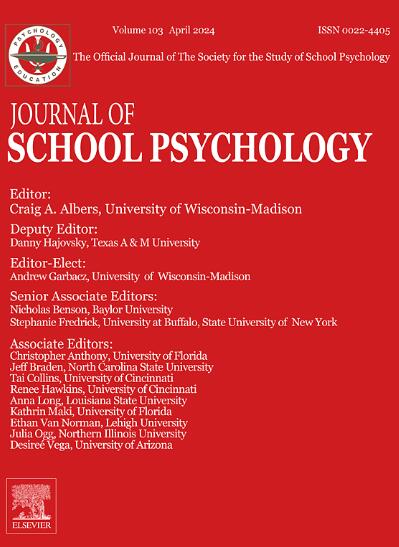情感交叉:划分考试焦虑、情绪障碍和学生福祉
IF 4.1
1区 心理学
Q1 PSYCHOLOGY, SOCIAL
引用次数: 0
摘要
以往的研究表明,考试焦虑与情感障碍的症状呈正相关,高度考试焦虑的人可以达到情感障碍的诊断标准。然而,许多研究都有些过时,而且是基于较早的关键概念。此外,人们很少将幸福感与考试焦虑和情绪障碍一并考虑。在本研究中,我们针对这一局限性,在使用与学校相关的幸福感(SRWB)的同时,还使用了与考试焦虑和情绪障碍同时出现的概念,并使用了两种很少被结合起来的分析方法来确定这些概念之间的关系。样本包括来自中学和高中教育的 1167 名参与者(男性 = 500,女性 = 621,非二元 = 21,拒绝报告 = 25;年龄 = 15.4 岁,标准差 = 1.81)。数据分析采用了心理测量网络分析和接受者-操作者特征(ROC)曲线分析。心理测量网络分析显示,考试焦虑、广泛性焦虑、惊恐障碍、社交焦虑、重度抑郁和 SRWB 形成了不同且基本一致的群体。广泛性焦虑主要与测试焦虑的担忧和紧张成分相关,惊恐障碍与生理指标成分相关,社交焦虑和 SRWB 与担忧和认知干扰成分相关,重度抑郁与认知干扰成分相关。ROC 曲线分析表明,第 63 到 75 个百分位数的考试焦虑分数可以预测临床风险,准确度相对较高(0.79-0.88),灵敏度(0.75-0.86)和特异度(0.70-0.77)也在可接受范围内。研究结果表明,考试焦虑、情绪障碍和 SRWB 是不同的概念,但又相互关联。尽管受到横断面设计的限制,但我们的研究结果表明,高度考试焦虑会增加情绪障碍的发病风险。本文章由计算机程序翻译,如有差异,请以英文原文为准。
Emotional intersection: Delineating test anxiety, emotional disorders, and student well-being
Previous studies have shown how test anxiety is positively related to symptoms of emotion disorder and that highly test anxious persons can meet diagnostic thresholds for emotion disorder. However, many studies are somewhat dated and based on older conceptualizations of key constructs. In addition, well-being is rarely considered alongside test anxiety and emotion disorder. In the present study, we addressed this limitation by using contemporaneous conceptualizations of test anxiety and emotion disorder, alongside school-related well-being (SRWB), using two analytic methods that are rarely combined to establish how constructs are related. The sample comprised 1167 participants (nmale = 500, nfemale = 621, nnon-binary = 21, ndeclined to report = 25; Mage = 15.4 years, SD = 1.81) from secondary and upper secondary education. Data were analyzed using psychometric network analysis and receiver-operator characteristic (ROC) curve analysis. The psychometric network analysis showed that test anxiety, generalized anxiety, panic disorder, social anxiety, major depression, and SRWB formed distinct and largely coherent communities. Generalized anxiety was principally linked to the worry and tension components of test anxiety, panic disorder to the physiological indicator's component, social anxiety and SRWB to the worry and cognitive interference components, and major depression to the cognitive interference component. The ROC curve analysis indicated that test anxiety scores from the 63rd to 75th scale percentiles could predict clinical risk with relatively high accuracy (0.79–0.88) and acceptable levels of sensitivity (0.75–0.86) and specificity (0.70–0.77). Results suggest that test anxiety, emotion disorder, and SRWB are distinct, albeit related constructs. Although constrained by the cross-sectional design, our findings suggest that high test anxiety presents an elevated risk for the development of emotion disorder.
求助全文
通过发布文献求助,成功后即可免费获取论文全文。
去求助
来源期刊

Journal of School Psychology
PSYCHOLOGY, EDUCATIONAL-
CiteScore
6.70
自引率
8.00%
发文量
71
期刊介绍:
The Journal of School Psychology publishes original empirical articles and critical reviews of the literature on research and practices relevant to psychological and behavioral processes in school settings. JSP presents research on intervention mechanisms and approaches; schooling effects on the development of social, cognitive, mental-health, and achievement-related outcomes; assessment; and consultation. Submissions from a variety of disciplines are encouraged. All manuscripts are read by the Editor and one or more editorial consultants with the intent of providing appropriate and constructive written reviews.
 求助内容:
求助内容: 应助结果提醒方式:
应助结果提醒方式:


